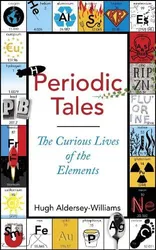This is another book about the elements in the periodic table, but unlike Elementary, it takes a more thematic approach, grouping the elements into five categories entitled Power, Fire, Craft, Beauty and Earth, with a section of the book on each. The book doesn’t attempt to cover every single element, instead focusing on those that have had the greatest significance in each of those categories.
The author goes on a wide-ranging tour of the practical and cultural relevance of the elements, covering music, literature, art, engineering and many other areas. We find out about the discoverers of the elements, how they discovered them, and how the elements were named. The book covers some of the physical properties of the elements, both in their pure form and within the compounds they form, and relates these properties to how they are viewed culturally. Often these cultural associations began long before humans even knew what elements were. For example, gold was valued for its colour and shine, while other metals were more useful for making weapons.
There are so many interesting little tales in this book. I particularly enjoyed the sections on elements that are (or were) valued for the bright colours they produce, and used in paints and dyes. It’s kind of amazing how many elements there are that were initially enthusiastically adopted for decoration, then discarded once we realised how toxic or dangerous they were. There are also many interesting characters among the discoverers of elements, and I enjoyed reading about the determination and ingenuity that they needed in order to claim their discoveries.
The elements were starting to be discovered around the same time that alchemy (the attempt to make gold from other substances) was gradually being replaced by a more modern understanding of science. The alchemists actually developed many of the techniques that were used to isolate the elements, and alchemists make frequent appearances in this book. I want to read more about them!
I was really interested to learn about how the cultural meaning of elements has changed over time. Aluminium, for example, was valued initially as an exotic and beautiful metal that was used for jewellery. But over time it has become associated with more commonplace uses such as cheap furniture and cookware. The author speculates that something similar could happen to Titanium, which is currently seen as a very futuristic and exotic material.
I enjoyed the sense of personal quest that the author brings to the book. He has a collection of the elements in physical form, and attempts to add to this at various points during the book. He meets with scientists who can provide samples, or who can help with experiments to try and make some elements in their pure form. The descriptions of these experiments are really fun to read about. He also visits places that were significant in the discovery of elements, such as the mine in Sweden where several elements were found.
It took me a little while to get into this book. Initally, I found the number of cultural references, and the speed with which they are discussed and then left behind, a bit overwhelming. But as I read on, the style and content began to make more sense to me, and I enjoyed the pick-and-mix approach of all the different ways in which the elements have influenced our world, both culturally and practically.
Although you will learn something about chemistry, and science in general, from reading this book, I don’t think that’s its main purpose. Instead it should be enjoyed for the tour it takes you on of the cultural history of the elements. You will learn more about literature, art, jewellery, war and engineering than you will about chemistry. I found it a really enjoyable read.
